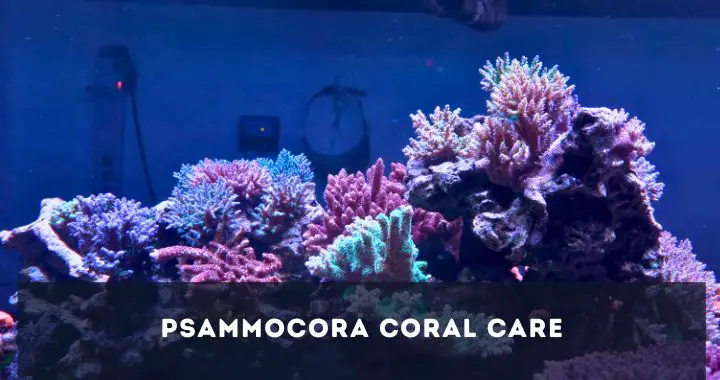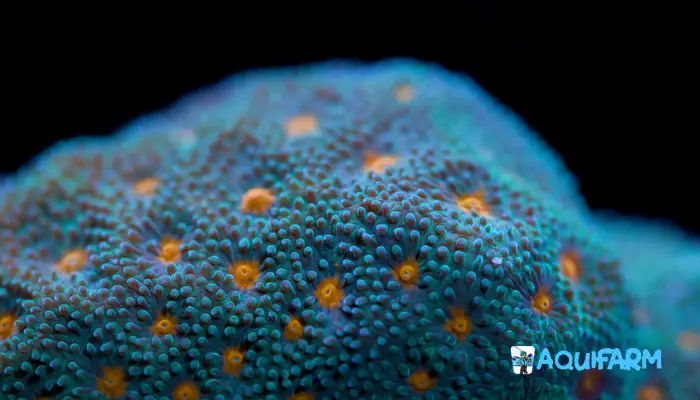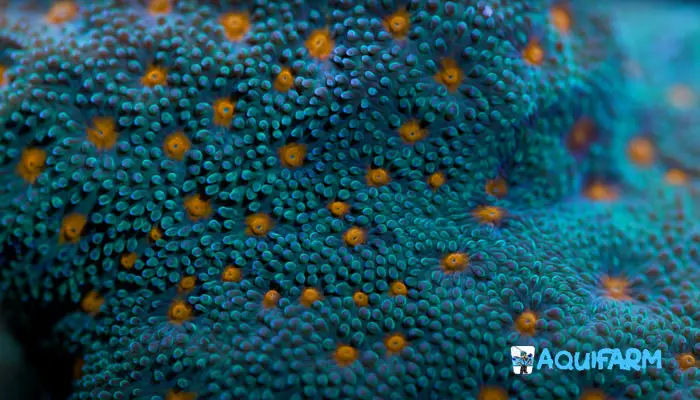
Psammocora corals are a bit rare yet mostly loved by aquarists. These vivid stony corals from monotypic families have another adorable name, the ‘cat’s paw coral’. If you are planning to conserve these reef beauties in your aquarium, you are in the right place.
In today’s article. I’ll take you on a ride through the growth factors of Psammocora corals sweeping all the necessary care.
Before diving in, let’s have a look at what they actually need in their surroundings.
Basic Care Requirements for Psammocora Coral

| Parameter | Range |
|---|---|
| Frag size | 2.5 to 5 centimetres |
| Light | 100 to 200 PAR |
| Temperature | 23℃ to 26℃ |
| Flow | Moderate to high flow |
| Calcium | 350 to 450 ppm |
| Magnesium | 1250 to 1350 ppm |
| Nitrate | Less than 10 ppm |
| Phosphate | Less than 10 ppm |
| Alkalinity | 8 to 12 dkH |
| pH | 8.1 to 8.4 |
| Salinity | 32 to 35 ppt |
Now, let’s dig a bit deeper focusing on some elementary factors.
Psammocora Coral Care: Meeting the Growth Needs of Psammocora Corals
Placement
Psammocora corals are easy adapters. But they need proper placement for better acclamation.
You can place these corals on exposed rocks. These can also be mounded with gel glue or putty. You just have to make sure that these corals can receive enough light and flow.
Psammocora are quite fast growers that’s why they can get out of control easily. To avoid such a situation, you can practice fragging regularly according to your need. Just place the fragments on a growing rock or in an isolated space to grow.
Moreover, you can always take larger sized tanks to grow Psammocoras. Mine are growing happily in a 30 gallon aquarium with other corals and also some fishes.
For better knowledge of coral acclimation in the new tank, you can check this video.
Light
Psammocora corals can be grown in different light conditions. However, they don’t thrive in natural sunlight, especially the watermelon Psammocora ones. A combination of blue and white spectrum lights is quite suitable. You can provide such with the help of aquarium LED lights, T5 fluorescent bulbs, or metal halide lamps.
I started with 100 to 150 PAR light intensity and it worked fine. As these are not that active in shifting color pigments, you can go with consistent light intensity.
However, I have noticed that Psammocora blooms more brightly in intense lights. In low light conditions, namely less than 50 PAR, they seem to show dull colors. So, it’s safe to keep them in between 100 to 200 PAR lighting range.
Though you can give them more than 200 PAR lights for more vivid colors, always go slow. Starting with dimmer lights like 50 to 70 PAR ensures easy adaptation to intense light. Gradually you can raise it to 200 PAR+ intensity. No matter what, always be careful in such a case as the corals can be burnt in sudden lighting changes.
Water Flow
Psammocora corals like moderate to high water flow. In other words, there should be at least such amount of flow that will not allow any deposition on the coral’s surface. Also, they need to be supplied with proper nutrients carried by moderate flow near the growing zone.
The availability of amino acids from the water column is only available in a stronger flow of water. However, in extreme flows, they can be pushed to stress. You might have noticed fragmentation due to continuous swirling water movement.
So, always keep such a flow in the tank that allows the gentle movement of the tentacles rather than haphazard motion and allows frequent fast flow with proper observation.
Growth Chemistry
As Psammocora are stony corals, to maintain the skeleton they need calcium and magnesium along with existing alkalinity.
In oceans, where naturally corals are formed, alkalinity levels lie between 8 to 9 dkH. Try to maintain this in your aquarium. But keep one thing in mind you need to balance the consistent alkalinity level, as fluctuations can tend to chemical changes in water hampering your coral’s growth. Even if your corals are adapted to low alkalinity, try to keep them at that level. You can gradually increase the alkalinity levels mimicking the natural condition but always go slow.
Adding calcium can often reduce the alkalinity in the tank. In such a case you need to check the magnesium level. It’s observed that in maintained magnesium levels, there are fewer fluctuations in alkalinity while adding the calcium supplements.
Normally the considered calcium and magnesium levels for growing Psammocora corals are 420 to 440 ppm and 1260 to 1350 ppm respectively.
You can adjust these chemical parameters 2 to 3 times per week according to your needs. But I always suggest maintaining consistency and gradual changes only.
Feeding
Many of the beginners ask me if the Psammocora okay with direct feeding. Let me tell you one thing, despite having small polyps, these are quite better feeders and absolutely comfortable with direct feeding. You can feed your Psammocora colony with the help of metal tongs.
When it comes to food, these corals are obsessed with oysters and roti-feasts. I’ve been noticing that my corals are good at feeding every two days. So, it’s wise to observe how your corals are reacting to regular feeding.
Here’s one tip for you, keep the phosphate and nitrate level low while feeding your corals. Both of these should be less than 10 ppm in your tank.
Some Common Issues With Psammocora

Psammocora coral not growing
This may be because of multiple changes in water parameters. Fluctuating water and nutrient level can be a major reason.
So, what’s the fix? As I have mentioned before, consistency is the key. Let your corals be adjusted with particular water conditions and don’t mess with these much.
Also look for reduced flow, as this can hinder the nutrients passage to the corals.
Pigment Fading
Fading is caused by inappropriate lights. Both too much and too little light can cause bleaching to your bright corals.
To avoid such conditions maintain the suggested lightning needs along with the proper temperature. If your corals are more prone to bleaching, do not go higher than 200 PAR. However, for my Psammocora 150-170, PAR is always a safe zone.
Algal and Bacterial Attack
Due to unhygienic conditions inside the tank algal and pathogen growth can take place. Cyanobacterium invasion is quite common in Psammocora. Also, negligence in regular water changes can promote slimy algal growth.
To prevent such aggregation, you need to change your tank water regularly. You can do this every one or two days depending upon your tank size and coral population. In my medium sized tank, changing water every two days worked fine. Also, try to avoid overfeeding your creatures and keep monitoring your filter performance.
Here I have briefly discussed some common problems. But there is always much more. You can check my other articles with better elaborations:
FAQs
What’s the growth rate of Psammocora corals?
Will Psammocora encrust my other coral species?
Are Psammocora aggressive to the other corals in the tank?
Conclusion
By this time, you might have realized Psammocora is not that fuzzy to keep as they are one of those easy to care corals. With proper monitoring, it won’t take that long to pick up the knack. All you need to do is to provide a stable and stress free environment to your psammocora, feeding them regularly and keeping an eye on them. That’s it and they are happy.
Let me know in the comments what you would like in my next articles. I’m all set to bring something exciting. Till then keep admiring your reef beauties.
- Top 15 Freshwater Aquarium Plant Ideas for a Lush, Green Tank - November 9, 2024
- Top 13 Freshwater Aquarium Layout Ideas for a Beautifully Organized Tank - November 9, 2024
- 14 Stunning Rustic Freshwater Aquarium Ideas for a Tranquil Environment - November 9, 2024
